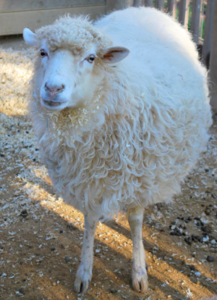
- VisitSupport Happy HollowDONATE TODAYExploreSupport Happy HollowDONATE TODAYLearnSupport Happy HollowDONATE TODAYSupportToday’s Hours: CLOSEDZoo on the Hill
Navajo-Churro sheep

Scientific name: Ovis aries
Family: Bovidae
Order: Artiodactyla
Class: Mammalia
Range: Originated from Spain; Domesticated worldwide
Habitat: Urban
Lifespan: 10 to 12 yearsWhat do they look like?
Navajo-churro sheep are medium-sized domestic animals. They have a dual coat, consisting of an undercoat of soft wool and an overcoat of longer hair. These sheep are most commonly black or white, but can also be brown, grey, two-toned, or piebald. The fleece (the undercoat and overcoat combined) can be a different color than the head and legs, which do not have wool covering them. Navajo-churros have a unique genetic trait that allows them to possess two, four, or even six horns. Rams (males) and ewes (females) can both have horns, although it is less common in ewes.How do they behave?
Navajo-churro sheep have a strong flocking instinct. They are a hardy breed that is able to adapt quickly to changing environments and are resistant to disease, making them ideal for coping with seasonal changes. Navajo-churro sheep are descendants of an ancient Iberian breed. Churra sheep were brought to North America in the sixteenth century by Spanish explorers. During Spanish colonization, Native American tribes acquired livestock through trades with outlying settlements. The Navajos raised and bred their sheep to expand their flocks. When European settlers arrived, the name “churra” was Americanized to “churro,” and a high demand for fine wool resulted in these sheep being crossbred with other breeds of sheep. They became known as Navajo-churro sheep to reflect their origins. Their adaptability and calm disposition make them ideal for producing wool.What’s do they eat?
Sheep are grazing animals, feeding on grass and other plant matter. At Happy Hollow, they are fed grass hay, grains, and are given opportunities to graze. How are they born? Ewes usually have one or two lambs per birth. They are not seasonal breeders and can produce two sets of lambs per year. Lambs are precocious (born with eyes open and able to stand within ten minutes, requiring little assistance from their parents) and are usually able to move with the flock within an hour.Conservation
The Navajo-churro sheep’s conservation status has not been evaluated by the International Union for Conservation of Nature , as a result of their designation as a domesticated species. However, sheep do play a vital role in conservation by helping impoverished communities through the Heifer International program. Heifer International works with rural communities throughout the globe to provide animals to subsistence farmers. These animals support sustainable agriculture and are vital sources of income to the members of their community. You can learn more about Heifer International and their programs at www.heifer.org
Zoo in the Hollow
Follow the crooked bamboo pathway down into the hollow and visit with some of the most amazing animals in the world. Where else in San José can you get up close to a stunning jaguar, lemur, meerkat or American alligator? Happy Hollow is dedicated to helping save species and preserve wildlife for future generations by participating in Species Survival Plan programs through the Association of Zoos and Aquariums.
See Animals
Education Ambassadors
From camps and classes to scout badges and sleepovers, Happy Hollow education programs have something for everyone! The zoo education program offers a broad range of hands-on, engaging programs and public presentations featuring education ambassador animals. These encounters are designed to connect you to wildlife and the conservation of their habitats around the world.
See AnimalsVisit Us Today
Plan an unforgettable experience at San Jose’s family-friendly park and zoo.
Learn More